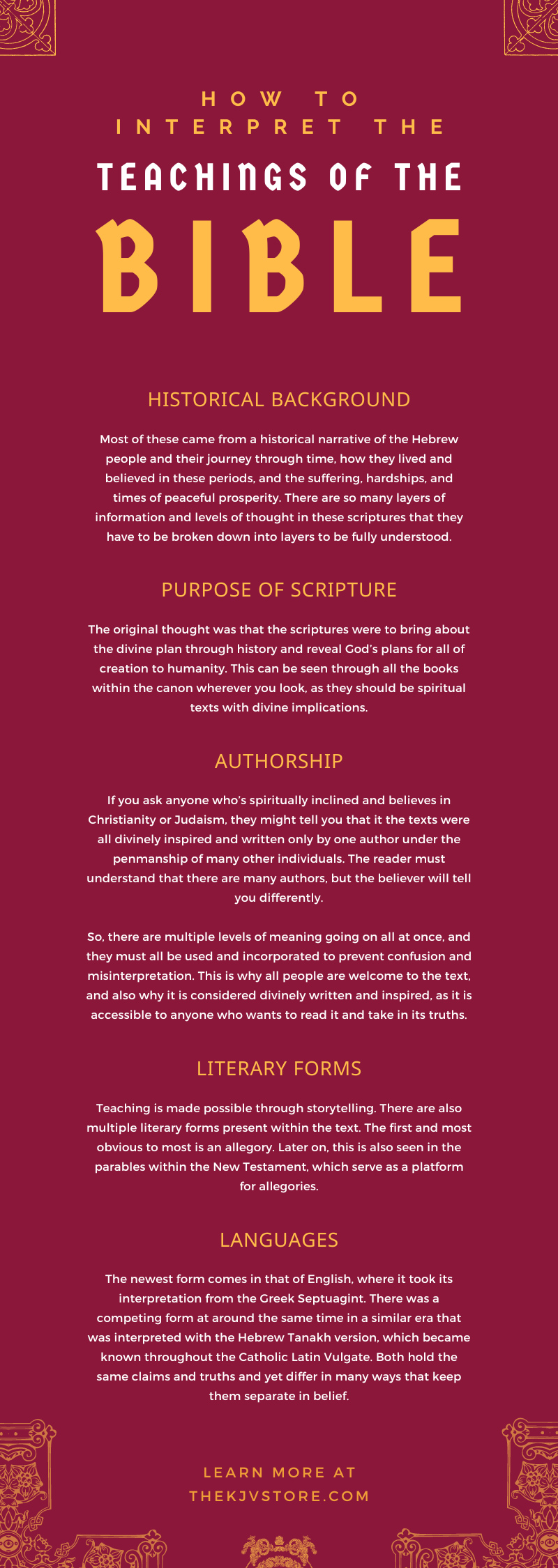How To Interpret the Teachings of the Bible

When anyone reads scripture from biblical literature, there is a wealth of knowledge that needs to be examined. The problem then lies in knowing how to use that information. Because the Bible is an ancient text, the context is skewed and needs to be read objectively with the correct time, place, and audience.
However, what makes this even more complicated is that the Bible is written in such a fashion that it calls to the reader to make the narratives as subjective and personal as possible. It takes on different forms, but the ultimate goal is to be used as instructional material for those who take the scripture seriously. Here are a few things to keep in mind on how to interpret the teachings of the Bible, so you can read and understand the true meaning of the text.
Historical Background
Many people may not realize this, but although the Bible is considered one text, it’s a library of ancient texts. The first thing that should be uncovered is a historical narrative or background. This is difficult to do, as there are 66 books contained within the Bible.
Most of these came from a historical narrative of the Hebrew people and their journey through time, how they lived and believed in these periods, and the suffering, hardships, and times of peaceful prosperity. There are so many layers of information and levels of thought in these scriptures that they have to be broken down into layers to be fully understood.
The Old Testament has been recorded and put into the canon throughout the last millennia, and it’s split into three ancient languages. The New Testament was newly added in the previous millennia over one hundred years, sometime after or around 500 AD. This puts a damper on many interpretations due to the older Hebrew way of thinking. This radical variant teaches something similar yet very different from the original text is the New Testament.
Purpose of Scripture
The original thought was that the scriptures were to bring about the divine plan through history and reveal God’s plans for all of creation to humanity. This can be seen through all the books within the canon wherever you look, as they should be spiritual texts with divine implications.
However, from a more contemporary perspective, people have come to understand the book as a moral guideline for teaching moral and ethical living, spiritual understanding, and even training for good work. There are many different ideas about what scripture is and its purpose, but defining this would go against the very cornerstone of literacy that it was founded on—an allegory and figurative language, in many instances.
Authorship
If you ask anyone who’s spiritually inclined and believes in Christianity or Judaism, they might tell you that it the texts were all divinely inspired and written only by one author under the penmanship of many other individuals. The reader must understand that there are many authors, but the believer will tell you differently.
The author commits to explain or instruct things about the scripture that could be taken personally by the individual reader, making it an entirely subjective reading. This could be examined and interpreted with a certain level of truth. However, it could also take on different forms.
The reason why there’s so much contention throughout the church and how interpretation works is because, to the believer, they are being instructed through the mouth of God. The church, on the other hand, may say something entirely different about how and what is being said through the text.
So, there are multiple levels of meaning going on all at once, and they must all be used and incorporated to prevent confusion and misinterpretation. This is why all people are welcome to the text, and also why it is considered divinely written and inspired, as it is accessible to anyone who wants to read it and take in its truths.
Literary Forms
Teaching is made possible through storytelling. There are also multiple literary forms present within the text. The first and most obvious to most is an allegory.
Later on, this is also seen in the parables within the New Testament, which serve as a platform for allegories. Parables are somewhat of a riddle, using coded language to discuss other higher truths from allegorical teachings of other biblical books. There is also a good bit of philosophy as seen in the wisdom teachings of the Psalms and Song of Solomon.
Poetry is seen throughout prayer and allegorical tales. And the use of symbology floods the text to incorporate deeper seeded truths in every book that might be interpreted on varying spiritual levels, from the most novice reader to the most avid teacher. Examples of these forms of literacy can be found in your hardcover Bible or through online Bible stores that also offer scriptural readings.
Languages
Although the text of the Torah and the Septuagint as the Bible has been named in the past, it carries the title of two testaments now in one binding. For hundreds and thousands of years, the Bible has been written, taught, spoken, and read in Greek, Aramaic, Hebrew, and English.
The newest form comes in that of English, where it took its interpretation from the Greek Septuagint. There was a competing form at around the same time in a similar era that was interpreted with the Hebrew Tanakh version, which became known throughout the Catholic Latin Vulgate.
Both hold the same claims and truths and yet differ in many ways that keep them separate in belief. So, you can see the good and harm that comes from a linguistic interpretation of different languages throughout many years.
Overall, the hope is that you have a better understanding of how to interpret the teachings of the Bible so you can see how conclusions are made and why the Bible is taught the way that it is.

